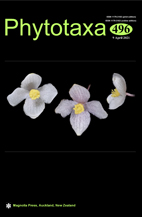Abstract
The Begonia species occurring in Bidoup-Nui Ba National Park (Lam Dong Province, southern Vietnam) are reviewed based on recent floristic field surveys. Five species were recognized from the montane forests, and two of which are new to science. The new species belong to Begonia sect. Platycentrum and are named as B. hongiaoensis C.W.Lin, T.C.Hsu & Luu and B. lamdongiana C.W.Lin, T.C.Hsu & Luu, repectively. Begonia hongiaoensis most closely resembles B. siamensis Gagnep from northern Thailand. Both species have a rhizomatous habit and bear ovate leaves. However, the new species differs by its stoloniferous habit, shallowly cordate leaf base and 5-tepaled pistillate flowers. Begonia lamdongiana is similar to B. coelocentroides Y.M.Shui & Z.D.Wei, a hairy leaf species of the same section in Yunnan of China, but is markedly distinct in its glabrous petioles, inflorescences, pedicels and ovaries, and larger bracts.

